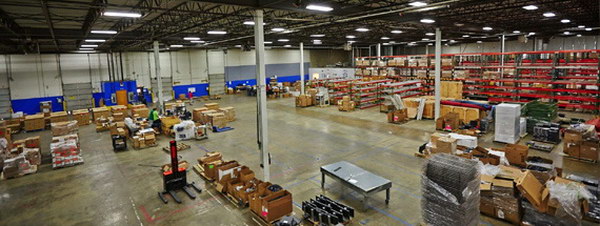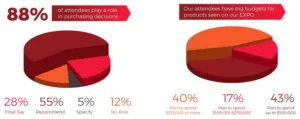When a consumer walks into a store, he sees shelves with groceries, racks with clothes, a line of televisions, etc. The exhibitors at the NRF’s Big Show, the annual trade show for retail technology held in New York January 14 – 16 and every January, see something different. They see a store as the end product of a technology and marketing system that includes everything from warehousing through the point-of-sale terminal, with all this tied together with extensive computer systems. The goal of exhibitors is to convince retail stores their technology is the best and will reduce costs or increase sales or, preferably, both. Displays are a major part of this technology and marketing chain, including the hand-held, and robot- and forklift-mounted displays used in warehouses, digital shelf-edge labels, POS displays, digital signage, wayfinding displays etc. Except for shelf edge labels, virtually all displays used in the retail industry are touch-screen displays.
Attendees at the NRF are not looking for ideas – they are looking for products to spend their company’s money on, with 40% of the 2017 attendees saying they were planning on spending $250,001 (€203,484) or more on the technology shown at the NRF.
NRF 2017 survey of attendees showing their budgets for technology shown at the Expo. (Credit: NRF)
The NRF Big Show focuses on technology, not other aspects of retail. In particular, there are relatively few marketing-oriented exhibitors and no retail products at all on display. Retail products all have their own dedicated trade shows, such as the CES, recently finished in Las Vegas, or the upcoming Toy Fair in New York.
The technology exhibited covers the complete range, including warehouses, back office operations, shelf-edge labels and small in-store displays, point-of-sale terminals and digital signage. The digital signage presence is somewhat modest and ISE in Amsterdam early next month is expected to have a much more extensive digital signage presence than the NRF. During my limited time at NRF, I largely ignored digital signage since I will also be at and report on ISE.
The software technology to tie retail together provides a major share of the exhibits at NRF, perhaps half of the show floor. All the big software providers are there, including Microsoft, Google, IBM, Oracle, Intel, Amazon, SAP, etc. In addition to all the big names, there were at least 100 software suppliers at the show I had never heard of with products dedicated to retail applications. This software technology ties together the computer hardware systems that handle the product; does the accounting at both a store and corporate level; does product planning to make sure items are in stock when consumers want to buy them; and runs the corporate websites for omni-channel and endless-aisle applications. Perhaps most visibly, the software also provides “analytics” AKA “big data” that helps marketing people at both the store and the corporate level make their plans and target individuals with products they are likely to buy.
Targeting comes to Retail
In the past, this precision targeting of individuals has mostly been done on-line. For example, Google targets ads at individual users based on their browsing history and other inputs. This targeted information for individuals is moving into stores with analytics driving smaller signage displays on sales counters to match the person looking at the items for sale. These in-store analytics are most commonly driven by in-store cameras and machine vision systems that not only identify gender, ethnicity and age of store visitors but sometimes can identify individuals based on facial recognition. One application I saw used facial recognition to compare all store visitors to a national database of criminals. The demo at the NRF expo said that one individual had a 65% chance of being a notorious shoplifter in the database. Creepy!
The NRF Expo has a bewildering variety of hardware and software options for retailers. No doubt, many were incompatible with each other and would cause problems when a retailer, large or small, tried to integrate them into his store or chain of stores. I spent some time talking to David Strickler, President & CEO of Spencer Technologies. His company has provided integration and other services to large and small retailers world wide since it was founded in 1972. Currently, the company has 15 offices, about 500 employees and 200+ active retail accounts. Strickler says the company’s business is about 30% project planning, 30% building and the rest maintenance.
 Some of Spencer Technologies clients (Credit: Spencer Technologies)
Some of Spencer Technologies clients (Credit: Spencer Technologies)
According to Strickler, Spencer Technologies is vendor-neutral and will work with the hardware and software selected by the retailer to integrate it with both the retailer’s existing systems and other new systems bought from other vendors. His company then ensures there is no finger pointing with Vendor A claiming a problem is Vendor B’s fault and vice versa. As the integrator, the problem becomes Spencer Technologies’ problem, not the retailer’s or either vendor’s. Spencer Technologies also stocks replacement parts for key systems in its depots in the US, Canada, Latin America and Europe for quick resolution when problems do arise. At these depots, it can stage systems to be installed and pre-test them, minimizing or eliminating down time at the retail establishment when switching or upgrading systems.
 A Spencer Technologies Depot (Credit: Spencer Technologies)
A Spencer Technologies Depot (Credit: Spencer Technologies)
“Off-line brick-and-mortar retail is under siege from ecommerce, creating an opportunity for the most innovative companies to set themselves apart in an ever-changing climate,” said Strickler. “If retailers can rely on a single vendor to service all their in-store technology needs, we can serve as a trusted partner and extension of their team, allowing them to devote more resources to navigating their business through this challenging period.”
In a broader discussion on retail in general, Strickler set me straight on two buzz-words commonly used at NRF, “Omni-Channel” and “Endless Aisle.”
An omni-channel retailer treats all channels into the retail market as one and the same channel. Specifically, he treats his on-line business, whether based on mobile apps or desktop browsers, and his brick and mortar stores as a single business, not two or three separate businesses maintaining separate inventory systems and price lists.
Endless aisle is a sub-set of omni-channel. It is where in-store displays, touch screen, of course, allow a store customer to find an item similar to the one in the store somewhere else in the retailer’s inventory. It could be located in the store’s stockroom, another store in the chain or the retailer’s warehouse. That way if a customer likes an item, but the one in the store doesn’t fit or is the wrong color, she can find it elsewhere in the system, order it immediately without leaving the store and have it shipped either to her home or to the store for pickup. This saves the customer from having to go home, find the retailer’s website and ordering the item on-line. Retailers hate this because the customer often doesn’t order it on-line and the sale is lost.
This leads to another buzz word, “Conversion Rate.” Basically, the conversion rate is the percentage of store customers who express interest in a product and then go ahead and buy it. A store can increase its sales either by increasing its traffic or increasing its conversion rate with the existing traffic.
At the Big Show, “Analytics” was a far more popular word than “Big Data,” which for many people includes connotations of an invasion of consumer privacy. One of the main goals of analytics was to increase the conversion rate, i.e. increase the proportion of those people who examine an item who then actually then go on to buy it. Conversion rate and analytics apply to retail store, endless aisle and on-line sales. A retailer practicing the omni-channel approach doesn’t care which channel the conversion takes place as long as the sale is made. –Matthew Brennesholtz

